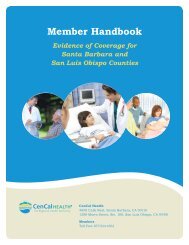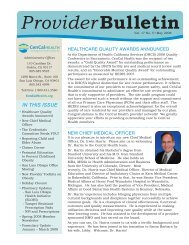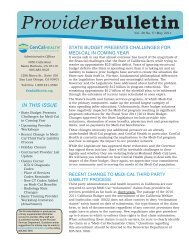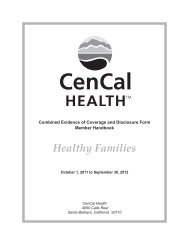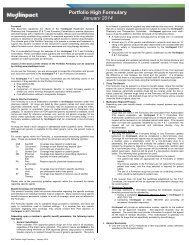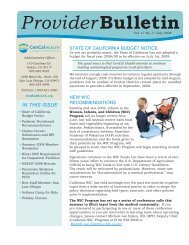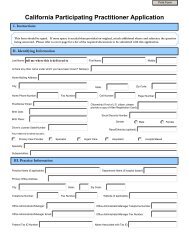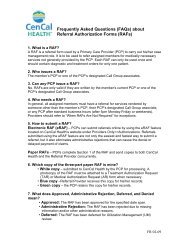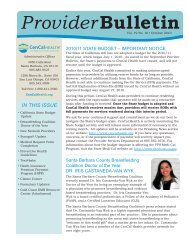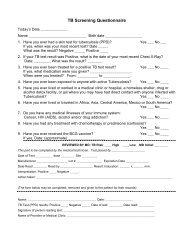Addressing Language Access Issues in Your Practice: A Toolkit for ...
Addressing Language Access Issues in Your Practice: A Toolkit for ...
Addressing Language Access Issues in Your Practice: A Toolkit for ...
You also want an ePaper? Increase the reach of your titles
YUMPU automatically turns print PDFs into web optimized ePapers that Google loves.
3 CALIFORNIA ACADEMY OF FAMILY PHYSICIANS<br />
Introduction<br />
The chang<strong>in</strong>g voice of Cali<strong>for</strong>nia<br />
In 1990, 8.6 million Cali<strong>for</strong>nians spoke a language other than English at home, and<br />
4.4 million were considered “limited English proficient” (LEP). Ten years later, <strong>in</strong><br />
2000, those numbers had <strong>in</strong>creased by 40%, with 12.4 million speak<strong>in</strong>g a language<br />
other than English at home and 6.2 million be<strong>in</strong>g identified as LEP. In Los Angeles<br />
County alone, there are significant communities of people speak<strong>in</strong>g Spanish,<br />
Ch<strong>in</strong>ese, Tagalog, Korean, Armenian, Vietnamese, Farsi, Japanese, Russian,<br />
French, Arabic, Cambodian, German, languages of the Pacific Islands, Italian and<br />
Hebrew. In the San Francisco Bay Area, only 54% of the population speaks English<br />
at home; 18% speak Ch<strong>in</strong>ese, and 12% speak Spanish. 1<br />
Cali<strong>for</strong>nia’s grow<strong>in</strong>g diversity is one source of its dynamic economy and culture.<br />
It also poses a challenge to anyone provid<strong>in</strong>g services to this <strong>in</strong>creas<strong>in</strong>gly diverse population. The voice of<br />
Cali<strong>for</strong>nia is chang<strong>in</strong>g; to speak to all Cali<strong>for</strong>nians, we must change too. 2<br />
Why is this an important issue?<br />
As a physician, you lead a busy professional life. In<br />
addition to all your cl<strong>in</strong>ical work, you may have to run<br />
a bus<strong>in</strong>ess as well. It seems as if you’re always be<strong>in</strong>g<br />
asked to provide more services <strong>for</strong> less compensation.<br />
It may feel to you that address<strong>in</strong>g the language access<br />
needs of your chang<strong>in</strong>g patient population falls <strong>in</strong>to<br />
this category. Still, it is up to you as a physician to provide<br />
quality care to each patient and to communicate<br />
clearly with each patient who seeks out your services.<br />
<strong>Your</strong> patients are depend<strong>in</strong>g on you.<br />
Communication is the absolute heart of medical practice.<br />
Studies have shown that more than 70% of the<br />
<strong>in</strong><strong>for</strong>mation on which physicians base their diagnoses<br />
comes from the history and physical exam. Anyth<strong>in</strong>g<br />
that compromises the quality of the communication<br />
between patients and physicians represents a threat to<br />
the quality of the care provided. Clear communication<br />
is hard enough, even with English-speak<strong>in</strong>g patients,<br />
when there are issues of low literacy or age to consider.<br />
When the patient does not speak English, communication<br />
becomes that much more difficult. In a 2003 study<br />
conducted by the Cali<strong>for</strong>nia Academy of Family<br />
Physicians, almost half the physicians surveyed were<br />
personally familiar with <strong>in</strong>cidents <strong>in</strong> which quality of<br />
care was compromised by language barriers. 3<br />
In such circumstances, it is not surpris<strong>in</strong>g that patients<br />
seek out (when they can) the health care practices that<br />
will allow them to communicate freely with their doctors<br />
and staffs. As the population <strong>in</strong> Cali<strong>for</strong>nia becomes<br />
more diverse, effective communication across languages<br />
becomes a real sell<strong>in</strong>g po<strong>in</strong>t to attract new<br />
patients to your practice.<br />
In addition to the impact that language barriers can<br />
have on quality of care, there are also f<strong>in</strong>ancial implications<br />
to unclear communication <strong>in</strong> health care, and<br />
legal implications when unaddressed language barriers<br />
lead to a poor health outcome or to unequal access to<br />
care. When communication is unclear, care is more<br />
expensive; that hurts <strong>in</strong>dividual physicians, <strong>in</strong>dividual<br />
payors, public systems of reimbursement, and the system<br />
as a whole. Clear communication controls costs. In<br />
addition, federal Civil Rights laws and a series of<br />
Cali<strong>for</strong>nia regulations and contractual stipulations<br />
Luckily, there are both a grow<strong>in</strong>g<br />
expertise and a grow<strong>in</strong>g number of<br />
resources available to assist you <strong>in</strong><br />
bridg<strong>in</strong>g the language gap with your<br />
limited English proficient (LEP)<br />
patients.<br />
require language access <strong>in</strong> health care. If you are <strong>in</strong>terested<br />
<strong>in</strong> learn<strong>in</strong>g more about the research related to<br />
quality, legal, and f<strong>in</strong>ancial implications of language<br />
barriers <strong>in</strong> health care, please see Appendix A.<br />
Because of these reasons, physicians around the country<br />
are start<strong>in</strong>g to view language access as an issue that<br />
must be addressed if medic<strong>in</strong>e is to serve the patient<br />
populations of today. In a national study <strong>in</strong> 2002, seven<br />
<strong>in</strong> ten of the more than 1,000 physicians surveyed <strong>in</strong>dicated<br />
that language barriers represented a top priority



